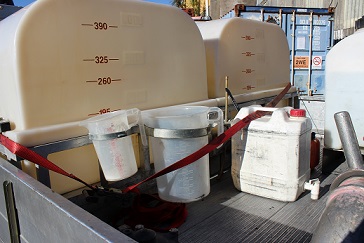Transport
 The requirements vary depending on:
The requirements vary depending on:
- Whether the agrichemical is classed as a dangerous good
- Why you are transporting the agrichemicals
- The quantity that is being transported.
Licensed transport operators must comply with all of the requirements of the transport regulations, regardless of the quantity being transported. You, on the other hand, who would generally carry agrichemicals as 'tools of trade' only need to comply with some of the requirements (provided that the amount you carry is below a specified quantity - the MTQ (maximum transport quantity) for that product). (Note: the MTQ is now also known as the Land Transport Schedule Exemption Quantity.)
The MTQs are determined by the 'packing group' of the product:
- Packing group I (High danger/risk): 5 litres/kilograms
- Packing group II (Medium danger/risk): 50 litres/kilograms
- Packing group III (Low danger/risk): 250 litres/kilograms.
If you carry more than the MTQ, you must have a D endorsement on your driver's licence. Otherwise, you'll need to arrange for the product to be delivered.
The packing group for a particular product is found on its HazNote or Emergency Safety Guide (ESG). For example, the HazNote for Weedmaster shows that its Packing Group is III which means its MTQ is 250 litres. This means you can carry up to 250 litres of the product without needing to comply with all the requirements of the transport regulations. The UN number signals it is classified as a dangerous good for transport.

General transport requirements
Regardless of the quantity carried, you must meet the following requirements when transporting agrichemicals:
- Protect the agrichemicals from water by covering the load if necessary
- Don't carry food, food packaging material and food containers together with any agrichemicals that have toxic or corrosive properties
- Secure your vehicle to prevent unauthorised access to the agrichemicals
- Make sure the agrichemicals cannot fall from the vehicle
- Prevent damage to the containers, spillage of the contents, contamination of people, animals or the environment when loading or unloading the agrichemicals
- Carry emergency response information for those agrichemicals classed as dangerous goods. A HazNote or Safety Data Sheet will meet this requirement and you can get this from your supplier. For all other agrichemicals, keep the invoices as a record of what is being carried
- Have a fire extinguisher in your vehicle if any of the products being carried are flammable.